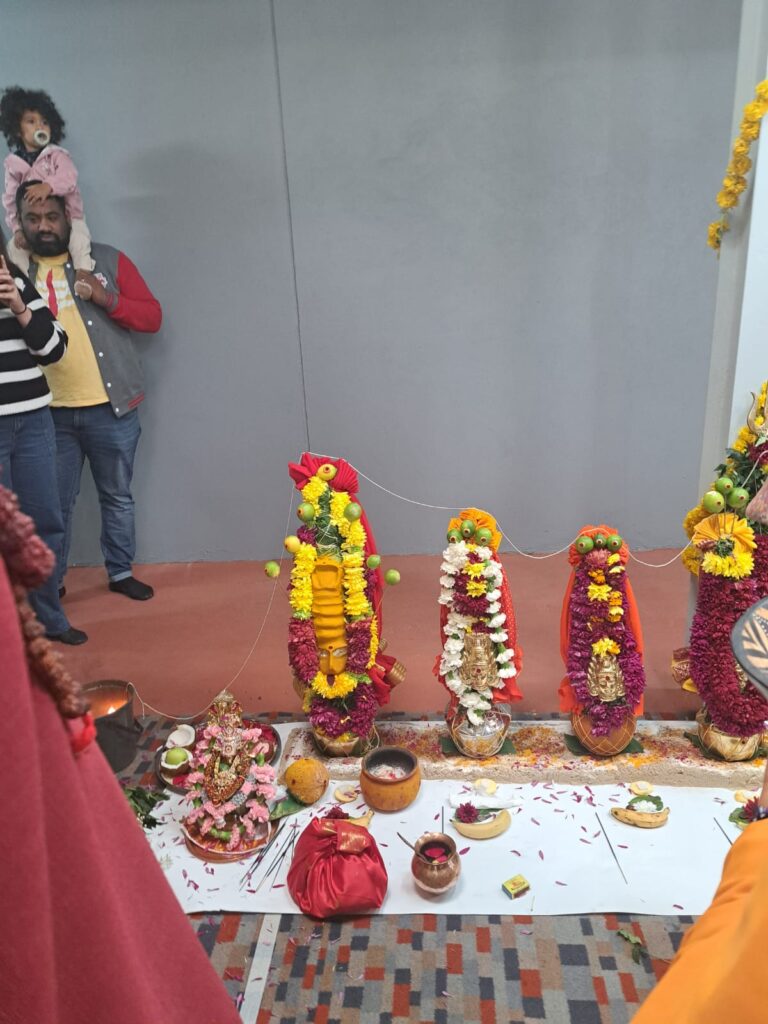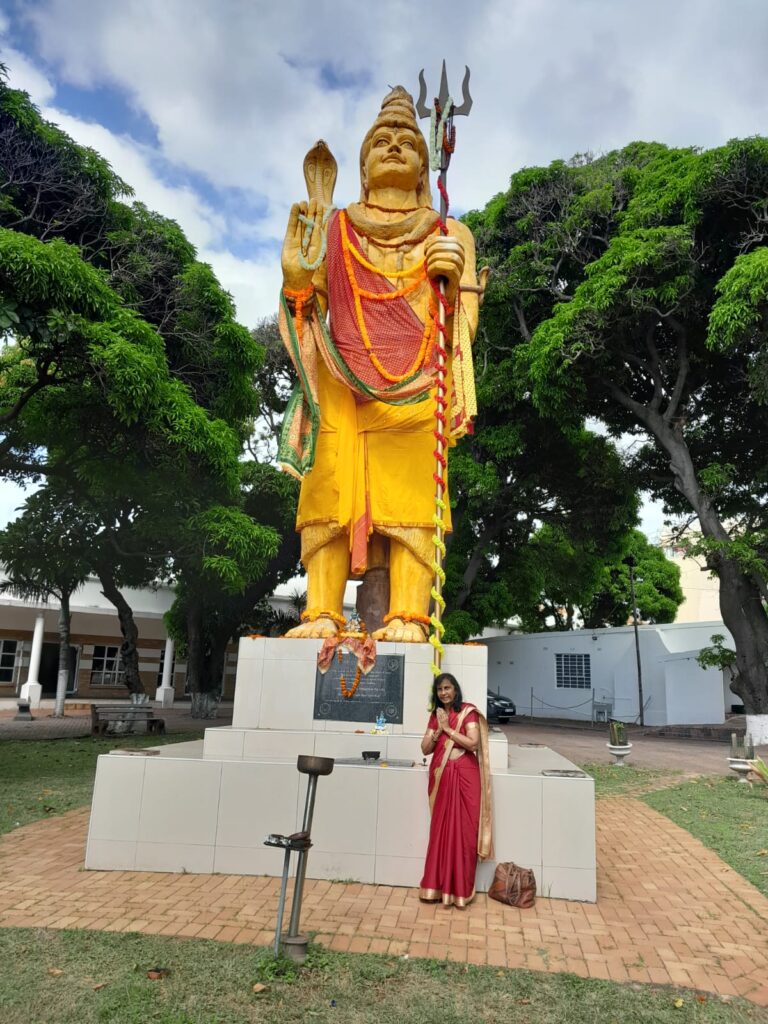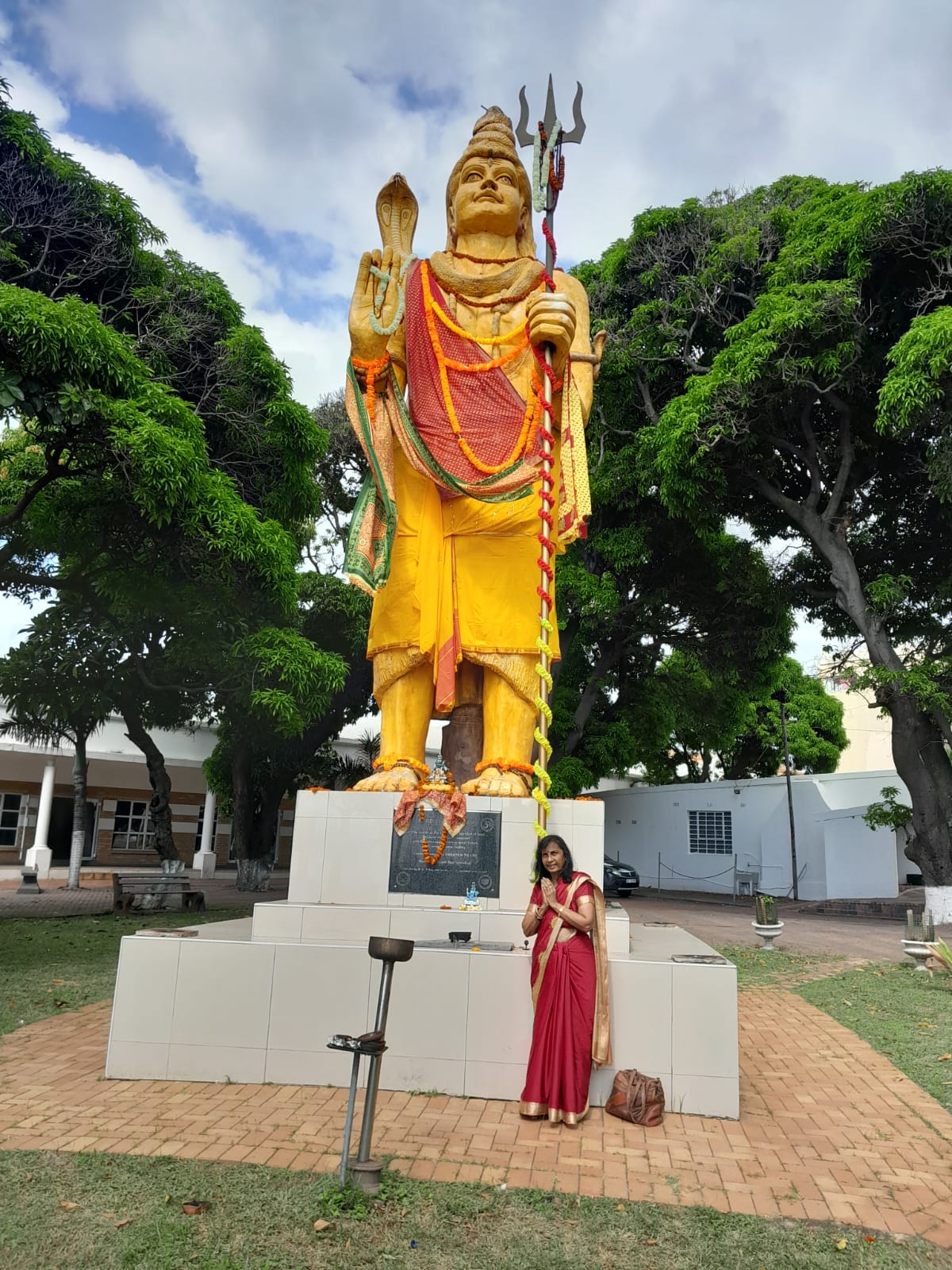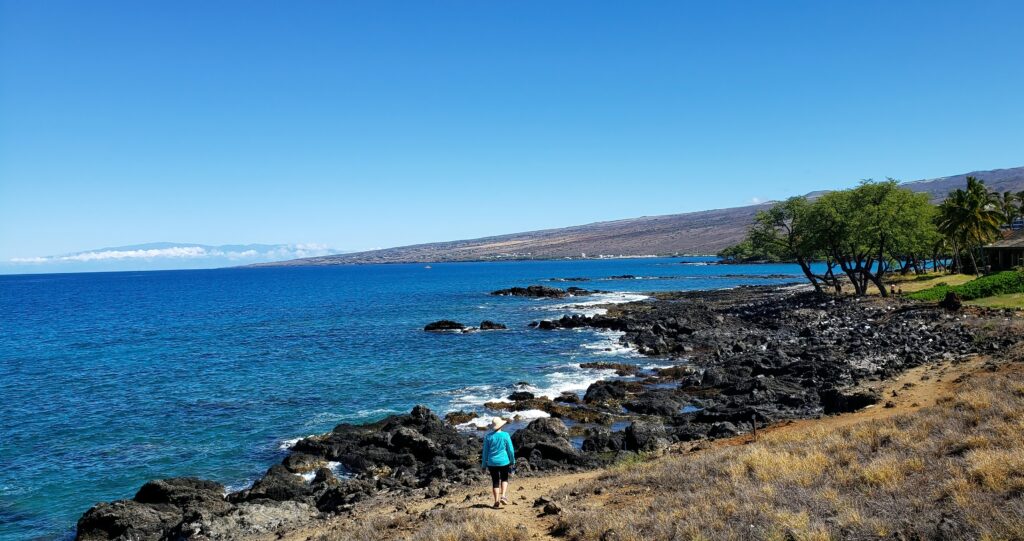South African Indians of Thamizh Origin who were brought by the British as Indentured labourers from South India to Natal from 1860 to 1906 to work in the sugarcane plantations have some unique customs that they practice. Due to certain circumstances they had to adapt in their new environment, but also preserve their customs and traditions.
They were compelled to work from sunrise to sunset and were only given leave from work on Sundays because their employers went to church. This led to The Aadi Mariamman Prayers being done on Sundays and not on Aadi Velli (Aadi Velli is the Fridays in the month of Aadi) as done in India. They tried to follow every little custom in South Africa, that was done in their Motherland.
Regular prayer services are usually conducted on Sundays in temples around South Africa. Prayer songs are chosen: some are devotional film songs, and some songs from Thevarum, Thiruvasagam and Thirupugazh. The Alayam Community members make their religious decisions in South Africa. It was decided that the first Sunday in Aadi is the most appropriate day to celebrate the Mariamman Prayer Festival because most families can do their Mariamman Prayers at home on the following Sundays. In some cities/districts that have three or more temples, Aadi Amman prayer festivals may be held on the second Sunday according to the Temple committee members’ decisions in their meetings.
Flag hoisting is done on the third, fifth, seventh or ninth day before the Prayer Festival. Alayam Committees in South Africa send WhatsApp notices to devotees that Flag hoisting will be done on a certain date.


In Cape Town, Our Siva Alayam in Rylands did the Mariamman Prayers on 21st July 2024 and the flag hoisting was on 12th July. The Parashakthi Alayam in Cravenby did the Prayers on 28th July.
Fasting begins on the day of the Flag hoisting. Prayer Services on Weekdays are usually at 6.30 pm to accommodate working devotees to rush to their homes after work, have a bath and come to the temple by 6.30 pm. On Saturdays, prayer services are usually at 2.30 pm and on Sundays at 9 am, 9.30 am or 10 am according to the usual time of the weekly temple Prayer Services. Meals are provided every day after the prayer service.
Devotees carrying the Kargams and observers join in the procedures of the daily Mariamman Prayers:

The Malar Archana (offering of flower petals) accompanied by mantras and turning of Aarthi around the deity is offered. First to Lord Ganesh, then all the Other deities. Then the Yegam /Harvan Special Mantras dedicated to Mariamman are offered. The Aarthi (camphor) is turned around and the conclusion prayers are done.
The meals are sponsored by devotees and the well-wishers. Soaking of the mealie meal to make porridge is done a few days after the flag hoisting Devotees who want to carry Karagams are required to register at least 2 days before the Flag hoisting. Usually, devotees pay a fee to carry the karagam. The Prayer list is circulated and the items needed for prayers are sponsored by lots of devotees attending the temple. The Alayam provides all necessary prayer items that devotees require, for example, fruits, milk, and flowers for prayers etc.
The day before the Main Mariamman Prayers Some devotees decorate their Karagams at home and others at the Alayam premises with lots of turmeric paste on their brass pots. They put kungum dots and lots of marigolds and other flowers. Syringa leaves are also used to beautify their Karagams. On the day of the Main Mariamman Prayers Devotees meet with their families in a designated place. In Cape Town Siva Alayam, devotees meet on school grounds in Rylands and if there is a smaller number of devotees, then they meet in the Alayam premises. The Parashakthi Alayam devotees meet at the school grounds opposite the Alayam or the Alayam premises. The Chariot with Amman statue is so beautifully decorated with syringa leaves (veppelai) and with marigolds and other beautiful flowers. As devotees enter the specified place, they first pray to the Amman in the Chariot. Devotees either stand in a line or a circle with their Karagams. The Prayer Service begins. The Gurukal and temple assistants first pray. They then turn the Aarthi for Mother Mariamman and then go around placing clean washed banana leaves, fruit, milk, flowers, agarbatti and camphor in front of Karagam on the banana leaves. Devotees then go to the area where temple assistants pour milk into brass pots of those carrying milk in their Karagams, some carry turmeric added to water, others carry rosewater, honey, thiruneer etc.,

When every devotee carrying Karagam returns to their place, the camphor is lit and the devotees pray. The Chariot procession starts with Devotees singing, musicians playing instruments like drums, tambourines, etc., and Gurukals and temple assistants leading the way to the Alayam. When the procession reaches the temple gate, camphor is lit. The procession enters the temple yard, and prayers are held in front of the temple Flag. Camphor is lit, and the procession goes around the temple three times, lighting camphor in the allocated four corners of the Alayam, and singing. The Chariot and devotees enter the temple.

Some Alayams allow their devotees themselves to do their Abeshegam and pour the milk first on the idol of Amman and then, followed by those offering turmeric water, rose water Honey Thiruneer etc., In some Alayams the Gurukal and not the devotees are allowed to perform the Abeshagam. The Gurukal does the whole Abeshegam the milk honey Thiruneer the milk etc., and the Abeshagam Abeshegam continues. As the Abeshegam is done ( the milk is collected in containers and later made into flavoured milk using rose syrup, ice cream, etc. The devotees later enjoy drinking the flavoured milk). Some devotees take some turmeric water or honey from the Abeshegam to their homes. Devotees sit in the Temple and services continue.

The food offerings, like sour porridge in stainless steel buckets, moringa curry, pumpkin curry, and curry with a variety of vegetables are cooked, seven rice flour lamps (mavu vilakku) made with cooked rice flour, condensed milk, sesame seeds, desiccated coconut then ghee and cotton wool wicks are placed in the lamps, kolicutters are made (made of semolina cooked in ghee with sesame seeds, jeera, condensed milk, and desiccated coconut), where small portions are placed in the palm, the fingers close over and are pressed. The kolicutter comes nice, long and thin. All are placed in front of the Mother. The rice lamps (mavu vilakkus) are lit. Songs are sung. In the closing prayer song each family, single person, or group of friends and all who came to the temple, join the line to go to the front to turn the aarthi, pray, and take sacred ashes and kungum from the priest, who stands at the entrance of the door. They put the ashes and dot on their forehead. Then people go to the feeding hall to partake of the meals.
Some temples dehoist the Flag on the same day while others do a special prayer on Tuesday. Kanchi Prayers are performed and unhoisting of the flag is done. Most Thamizhans do Mariamman Prayers at home on Sundays also. Usually, some families plan and choose which Sunday each sibling will do the prayer. The whole family is invited. The mealie meal is soaked about a week or a few days before the prayer. Tumeric paste is applied and kungum dots are put on the ‘outer sides’ of the containers in which the mealie meal is soaked. The fast begins: The families abstain from eating meat or alcohol smoking cigarettes etc., On the day of the prayer, a Kolam ( colourful designs made from coloured rice flour or wheat flour) is drawn. Some draw a square and draw beautiful patterns add an Aum sign and according to occasion or function, write the prayer name eg. Aum Sakthie and decorate it Then, garlands of marigolds, mango leaves and syringa leaves are put on the entrances of the doors
On the frame of the doors we draw many sacred signs, that is, with three middle fingers of the right hand we smear turmeric paste to make three straight lines and put a kungum dot in the middle of the three lines that we drew on the frames of the doors. Families that have little temples in their yards do their prayers in their temples. The same kind of Kolam in front of the temple and sacred patterns on the door frames are applied. Those who have no temples, pray at the altar inside their homes and then outside. Some pray at the entrance of their home first and then come inside and pray in their Pooja room. Some who have just a room or two, pray wherever their lamp and prayer areas are, inside their homes. There are no rules so a person is free to pray however he/she is happy and feels it right.
Most devotees make soured porridge, that is mealie meal soaked in water and cooked. We add sour milk, finely cut onions and shallots to the porridge. We call that Kulu. We cook three kinds of curries. It is usually drumstick herbs (murungakai leaves), pumpkin, mixed vegetable curry with drumsticks and we make pea dhal vadas, and gulgulas (balls made of cooked cake flour, milk, and sugar and sprinkled with desiccated coconut.) Pongal, that is white rice cooked with butter and sesame seeds made into small balls sprinkled with desiccated coconut, seven lamps (mavu vilakkus) made with cooked rice flour, butter sesame seeds condensed milk and sprinkled with desiccated coconut, kollicutters and seven kinds of seeds eg., butter beans, sugar beans, moong dhal, etc., are prepared as food offerings.
Most Amman devotees pray in the mornings before 12:00 pm. A few devotees (who slaughter animals, like goats, lambs or fowls) do their prayers in their yards outside their homes. They do their sacrifice outside and then pray with the porridge (we say kuloo) and also cook drumstick herbs (murungakai leaves), pumpkin and mixed curry. Pongal balls (flavoured white rice, cooked with butter, and condensed milk and made into small balls with desiccated coconut sprinkled; Seven cooked rice lamps, kolicutters, seven kinds of cooked seeds eg. sugar beans, broad beans etc. in their little temples. Those who sacrifice animals, cook the meat, and rice, make vadas, and gulgulas (little round balls made of cake flour, milk, and sugar some prefer to put a little rose syrup and fried in oil and sprinkled with desiccated coconut) and do a second prayer towards the afternoon. Most Mariamman devotees pray to Mariamman without any meat and do just the morning prayer before 12 pm. Only some devotees do a concluding prayer on the following Tuesday with Kanchi and call it Kanchi Prayers.

The Amman is the main deity in the middle of the Parashakthi Alayam because it is the Parashakthi Alayam. As you enter any specific Alayam, if it is The Muruga’s Alayam the main altar will be dedicated to the Lord Muruga etc. In all temples, the first altar is dedicated to Lord Ganesh, then the second to Lord Muruga, Shivalingam and or Goddess Maha Shakthi. The last altar has the deity of Maha Vishnu, only if it is Vishnu Alayam, the main altar will be Maha Vishnu with the altar of Lord Ganesh and other idol of deities , etc. in their altars.


This Siva Subramanium Temple in Umgeni Road Durban is one of the oldest temples that was built by the early settlers who came to South Africa. After many many years, I visited this historic temple again. The Shiva Monument is a new addition. This is a unique Alayam.
About the Author – Sushiela Govender, Cape Town

Born in Durban, SA into a Tamizh family and settled there a couple of generations back, Sushiela Govender won Best Indian Album at the South African Traditional Music Awards (Satma) held in Durban in 2009. Formerly of Malvern and now living in Cape Town, she is a retired school teacher with more than five decades of experience in the music industry. She has released the devotional CD Dharshan, A Prayer for All and another CD Anbumalai, which was released in 2003.
To know more about her, you can refer to these Youtube links, courtesy: minnambalam.com



